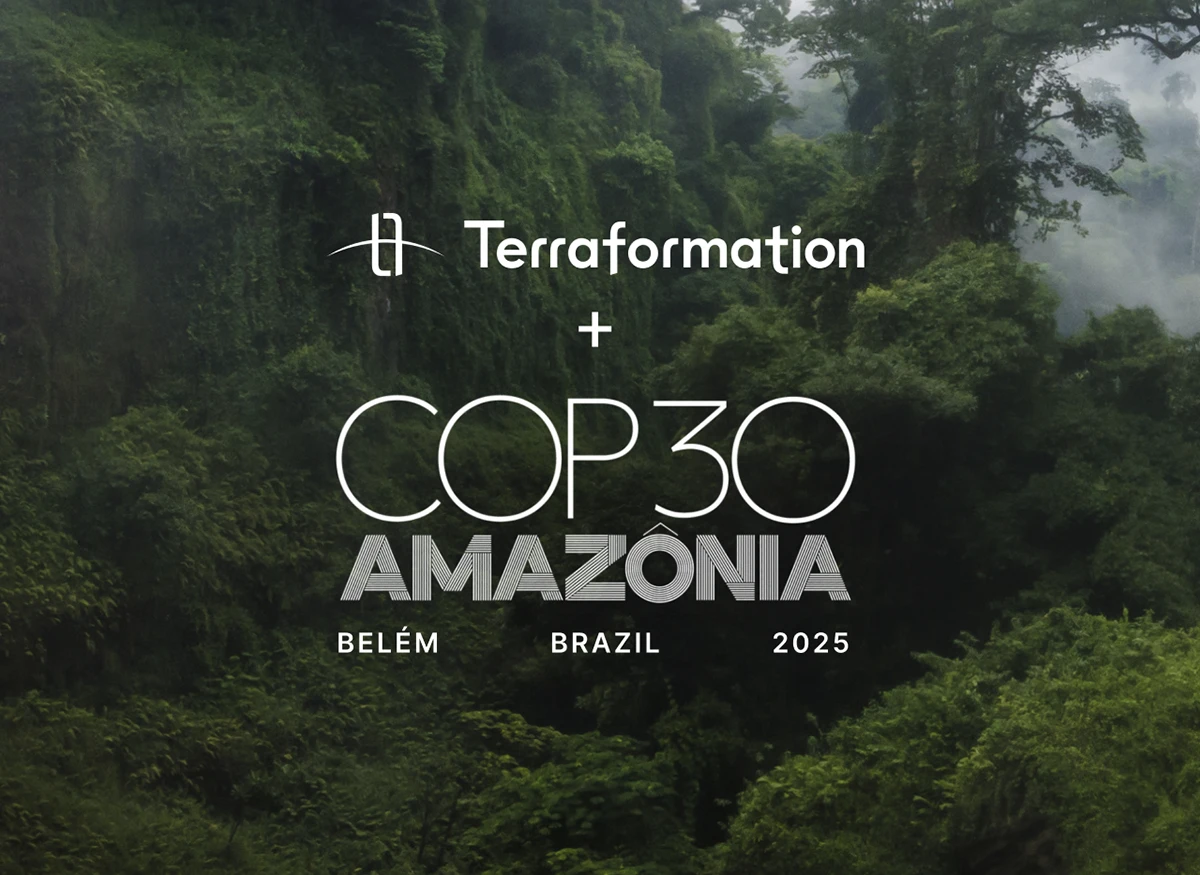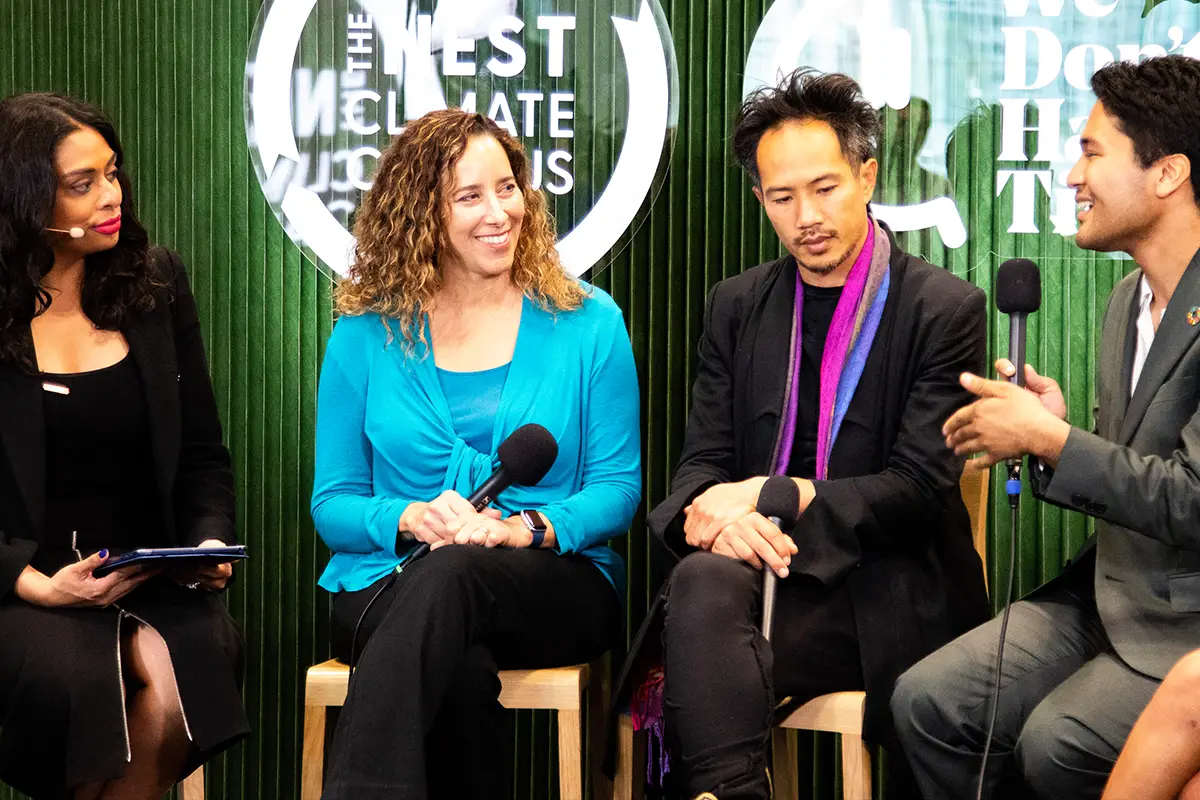After the hottest year on record, did COP28 improve the path to 1.5C?

Five Terraformation experts in forestry, green finance, social science, carbon markets, and forest restoration operations give their perspectives.
COP28, the UN climate change conference held this year in Dubai, ended with a mix of optimism and disappointment among attendees focused on strong climate action. As the first “global stocktake” following the Paris Agreement in 2016, the conference addressed the urgency of carbon reductions — but also revealed deep divisions among nations about reducing fossil fuel use to achieve the 1.5ºC goal.
We asked five Terraformation experts in forestry, green finance, carbon markets, social science, and restoration operations for their perspectives on the outcomes of the climate summit. Their responses offer a unique look at COP28’s implications for the voluntary carbon market and funding for restoration in some of the planet’s most critical forest ecosystems.
The voluntary carbon market (VCM) was in the spotlight throughout COP28. Are carbon credits part of the solution, or do they only delay companies from reducing their emissions?
“The carbon credit mechanism should be seen as a means of directing investment toward developing countries. I've been working with leaders in the Global South for the past 15 years, and the sense of injustice from countries experiencing the worst effects of climate change and not seeing constraints on the root causes is unavoidable. Climate change is, first and foremost, a social problem.
Abandoning the notion of ‘offset’ in favor of ‘contribution to global neutrality’ will help companies invest for the right reasons. The VCM is an important solution, but a small solution compared to the overall financing required for climate action, including for the adaptation of populations already suffering from rising sea levels, increased droughts, and torrential rains.”
- Damien Kuhn, Vice President of Forestry Partnerships and Development, based in Togo
“Voluntary carbon offsets have been and continue to be an important part of climate plans for organizations that are serious about addressing their climate impact. COP28 was another missed opportunity for the signatories of the Paris Agreement to integrate the voluntary and compliance carbon markets. But even without decisive action to integrate those two sides of the market, we continue to see demand for high quality afforestation and nature-based carbon removals. Carbon offsetting programs are one important source of funds for these nascent forestry teams.”
- Yee Lee, Vice President of Growth and Capital Markets, based in the United Kingdom
“The voluntary carbon market is one of the few functioning financial mechanisms to successfully reduce and remove carbon from the atmosphere. The Mitigation Hierarchy framework must be the North Star of any climate strategy: first reduce ongoing emissions and then invest in carbon projects to neutralize the remainder. Because this framework relies on carbon removals to be successful, it’s crucial to consolidate carbon market integrity standards. Demand for high-quality carbon credits will increase when buyers have clear, simple rules to guide them.”
- Alessandro Spagarino, Climate Impact Advisor, based in the Netherlands
“Voluntary markets, though imperfect, enable companies to take immediate action that also help them prepare for whatever those future states will be. Many of the companies I spoke to are not operating in carbon markets to delay reducing emissions — they are doing it to get ahead of business opportunities and risks for their customers or areas of operations as complementary to, not as a substitute for, work on emissions reductions.
From the industry side, I heard two important themes among carbon project developers and carbon buyers: 1) how to balance efforts to align around quality standards with the need to enable companies to take action now, and 2) how to make sure that beyond-carbon benefits for community and biodiversity are more clearly valued. It is clear that nature, more broadly defined, will be an increasingly important part of corporate considerations.”
-Berry Kennedy, Vice President of Operations, based in the United States
COP28 brought together the world’s governments and largest corporations. Are they the right stakeholders to design the world’s strategy for slowing climate change?
“Today, governments and large corporations are essential actors in the design of policies and strategies to fight the climate crisis. However, we must include the people who are most suffering from the direct and indirect effects, who should be the main beneficiaries and ultimate owners of any carbon projects or reduction activities, particularly with restoration projects. We must ensure that local communities and Indigenous knowledge are integrated into the very initial design of those projects, to ensure full ownership and transparent governance structure.”
- Alessandro Spagarino, Climate Impact Advisor
“There are two areas that we see the most promising potential for public-private sector interaction. First: we believe that governments can wield regulatory pressure in beneficial ways, for example, requiring climate and nature-related financial risk disclosures to provide true accounting of all the costs on nature and climate of their current business operations.
This will ultimately move markets to (correctly) drive up the value of private sector companies that operate in a regenerative way and deplete the market value of companies that operate in extractive ways. Second: we believe that governments can play an important role in spurring the expansion of new markets, for example, in providing grants and concessionary financing to help new forestry teams get off the ground.”
- Yee Lee, Vice President of Growth and Capital Markets
“Strategy is not sufficient. We need action. For resources to really make an impact, they need to be deployed at the local level and implemented with good projects that have committed project leaders. Yet a large part of this money remains blocked at ministerial or institutional level, without reaching the community level. There is a significant gap between the announcements made at COP and the real capacity on the ground to implement them. There aren’t enough teams and projects capable of delivering impacts on the ground.”
- Damien Kuhn, Vice President of Forestry Partnerships and Development
“National governments play a key role in developing plans and setting targets, and large corporations have access to large amounts of money needed to implement change. However, all stakeholders need equal, if not equitable, representation in developing climate change strategies, especially small island states, Indigenous peoples, and local communities, who are disproportionately impacted by climate change.
We also have to ask: are the representatives of each group an accurate representation of the people, are they able to create solutions for all, are there intersectionalities that compound vulnerabilities? These are all questions we ask as a project developer when mapping out stakeholders with our local partners. The same standard should apply to global decision-making strategies.”
- Meagan Suri, Senior Social Impact Lead
“Government and corporations are important stakeholders, but unless the strategy builds on the insight and input of all stakeholders — including local communities, youth, civil society, Indigenous peoples from all corners of the globe — it's unlikely to have the long-term buy-in to succeed. I was happy to spend some time at COP with our partners in Kenya, Eco2Librium. Listening to the voices of foresters doing the hard work on the ground is essential. I shared a meal with a friend of Terraformation, Elizabeth Wathuti, an advocate from Kenya who founded the Green Generation Initiative and who has helped garner support for including more youth voices in the COP processes on an annual basis.”
-Berry Kennedy, Vice President of Operations
The final COP28 agreement calls for countries to shift their energy infrastructure away from fossil fuels. What does this important transition mean to our climate emergency today?
“I was quite disappointed by the lack of a reference to a ‘phase out’ of fossil fuels from the final text. Saying ‘transition away’ is ambiguous — it leaves room for business-as-usual and doesn’t define clear milestones or deadlines to achieve such transition. The remaining carbon budget is shrinking, and carbon emissions haven’t peaked yet. This means that removals have never been so crucial.”
- Alessandro Spagarino, Climate Impact Advisor
“One hundred and ninety-seven countries agreed on the need to move away from fossil fuels, which still provide 80% of the world's energy mix. And to think there were 27 COPs before that didn't dare write the words ‘fossil fuels’! It’s a strong signal. With this consensus on the transition away from fossil fuels, the ostrich has pulled its head out of the hole. When awareness is matched by action, there's real change.
For the time being, there is still a huge gap between words and deeds. The UAE plans to increase production from 3.5 million barrels of oil per day to 5 million by 2027. I’ll congratulate them when the ostrich starts running.”
- Damien Kuhn, Vice President of Forestry Partnerships and Development
“The statement on transitioning away from fossil fuels was an important step and one that I hope will become a reality. I hope that part of the transition away from fossil fuels also focuses countries and corporations on the opportunities that they can transition towards — including investment in nature-based solutions that help ensure we not only sequester carbon, but also ensure our water, air, food, and fiber are resilient and abundant.”
-Berry Kennedy, Vice President of Operations
Did COP28 improve the path to achieving the Paris Agreement’s goal of limiting planetary warming to 1.5ºC?
“We need to recognize the positive elements of the final text, such as the targets for tripling renewables and doubling energy efficiency, the framework for the Global Goal of Adaptation and operationalizing the loss and damage fund with the related initial down payment. But the lack of clear pathways and targets for a total fossil fuel phase-out, a complete failure in agreeing on Article 6, and ambiguous reference to the end of subsidies for ‘unabated’ fossil fuels in the energy sectors will likely hinder the Paris goal of limiting warming to 1.5ºC.”
- Alessandro Spagarino, Climate Impact Advisor
“No, collectively we're still a long way from being able to avoid exceeding +1.5°C of warming: current commitments would enable a reduction of just 5% in greenhouse gas emissions by 2030 — compared with the -43% recommended by the IPCC.”
- Damien Kuhn, Vice President of Forestry Partnerships and Development
“No. Most COP28 participants expressed frustration in public discussions and after hours events that the international community is not doing enough. While it’s important to celebrate success and opportunities, it's also important to recognize that it’s not yet enough, and there are real and serious consequences to millions around the globe.”
-Berry Kennedy, Vice President of Operations
What are the immediate next steps governments, corporations, NGOs, and local communities can take to make incremental progress heading into 2024?
“We cannot wait any longer. Governments, corporates, local communities and NGOs should immediately collaborate in designing and implementing public-private partnerships to accelerate carbon reduction actions. One of the most effective ways of such collaboration has proved to be the VCM. As a carbon developer, Terraformation welcomes any form of regulation that can increase confidence among actors and the quality and integrity of the projects, with the ultimate goal to boost the market and scale projects.”
- Alessandro Spagarino, Climate Impact Advisor
“Immediate next steps should be action — big meetings and talks need action to build trust. We also have to be prepared to live with climatic hazards. Unfortunately, it's the most vulnerable people who are going to suffer the most, so we need to show greater solidarity. In this sense, the operationalization of the Loss and Damage Fund (with pledges reaching $800 million) is good news from COP28. Remember that a few years ago, the USA and the EU were opposed to it!
If we are to adapt to this more uncertain world, we need to develop our human capacities and life skills, both individually and collectively. Improving our external climate starts with improving our internal climate: more coherence between our words and our actions, less consumerism, more empathy and generosity for the billions of people who suffer from climate change — in short, slowing down to focus on the essentials of life.”
- Damien Kuhn, Vice President of Forestry Partnerships and Development
“We all need to work together to make change, whether there are global strategies in place or not. Reality exists on the ground. Real lives are impacted daily, and these people are every one of us on this planet. It is you and me; someone’s mother, son, cousin, aunt, and grandfather. We need to work together to implement holistic solutions that have immediate impact and solve deep systemic issues.”
- Meagan Suri, Senior Social Impact Lead
















